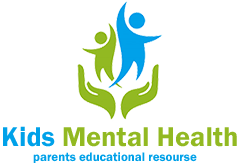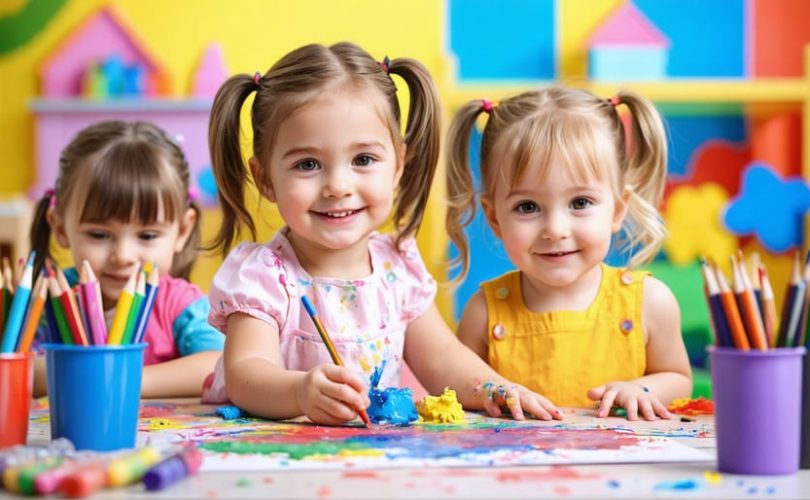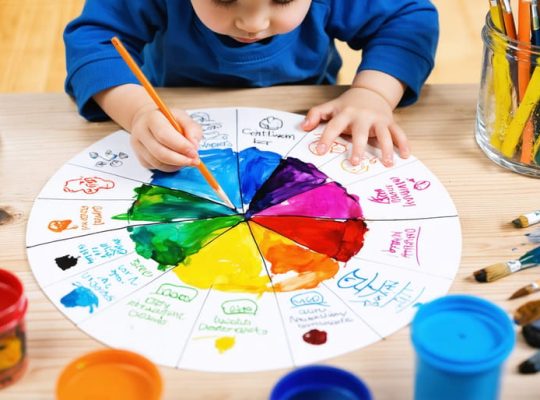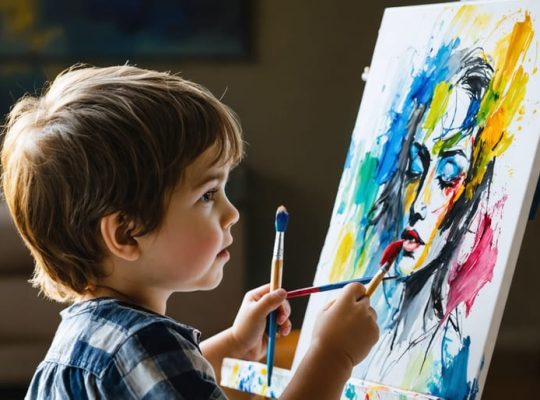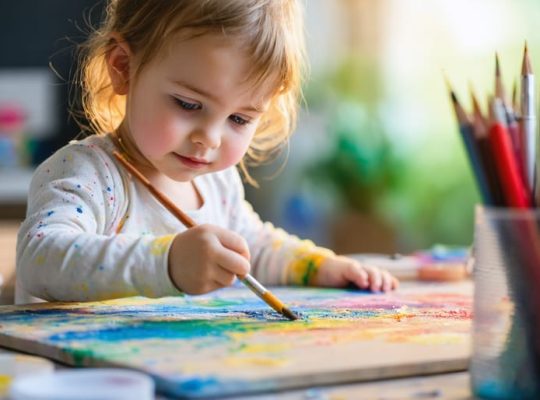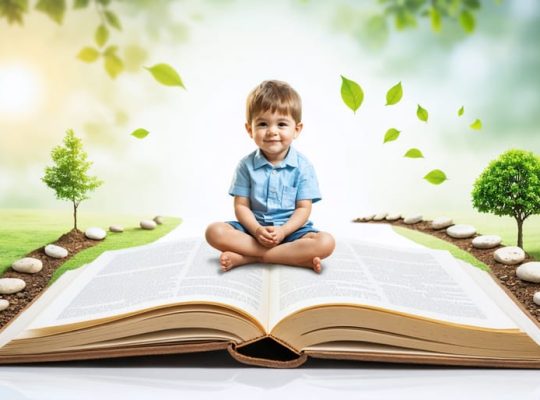Unleash your preschooler’s emotional intelligence through engaging arts and crafts that transform complex feelings into colorful, hands-on learning experiences. Creating emotion-themed artwork provides children a safe, natural outlet to express and understand their inner world while developing crucial social-emotional skills. From crafting simple emotion faces with paper plates to molding play-dough representations of different feelings, these creative activities help young children build emotional vocabulary and self-awareness. Whether at home or in the classroom, art-based emotional learning offers a powerful combination of sensory exploration, creative expression, and developmental growth that resonates deeply with preschoolers’ natural way of learning and communicating. These carefully designed projects not only foster emotional intelligence but also strengthen fine motor skills, encourage social interaction, and build confidence through artistic self-expression – all while keeping little hands busy and minds engaged in meaningful play.
Why Art Matters for Emotional Development
The Science Behind Art and Emotions
When children engage in creative activities, something remarkable happens in their developing brains. Research shows that art therapy for children and creative expression activate multiple areas of the brain simultaneously, strengthening neural connections. Drawing, painting, and crafting help release feel-good chemicals like dopamine, which naturally boost mood and reduce stress. These activities also engage the sensory areas of the brain, helping little ones process their experiences in a tangible way.
For preschoolers, who often struggle to put their feelings into words, art provides a natural outlet for expression. When they squish clay or splash paint, they’re not just creating – they’re learning to regulate their emotions through physical movement and creative focus. This hands-on approach to emotional learning creates lasting pathways in the brain that support healthy emotional development.
Signs Your Child May Benefit from Art Expression
Watch for signs that your child might benefit from creative expression through art. If your little one struggles to verbalize feelings, becomes easily frustrated, or experiences frequent emotional outbursts, art activities can provide a valuable outlet. Children who are going through big changes, like starting school or welcoming a new sibling, may also find comfort in artistic expression. Similarly, quiet or withdrawn children often open up when given the opportunity to communicate through drawing or painting. Notice if your child seems anxious, has difficulty sleeping, or shows changes in behavior – these could be indicators that they need additional emotional support. Art therapy techniques can be especially helpful for children processing difficult experiences or adjusting to new situations.
Simple Art Projects for Different Emotions
Happy and Excited Expressions
When children feel happy and excited, they often have boundless energy that’s perfect for creative expression. Finger painting is an excellent way to channel this positive energy – provide bright, cheerful colors like yellow, orange, and pink, and watch as their joy transforms into sweeping strokes and playful patterns on paper.
Create a “Happy Thoughts Collage” by having children cut out pictures from magazines that make them smile. They can arrange these images on colorful paper and add sparkly stickers or glitter for extra excitement. This activity helps them identify and celebrate what brings them happiness.
Another engaging project is the “Joy Dance Painting” – place large paper on the floor, put on upbeat music, and let children dip their feet in washable paint. As they dance and move to the rhythm, their footprints create unique patterns reflecting their excitement. This combines emotional expression with physical activity.
For a quieter option, try the “Sunshine Crown” – help children cut and decorate paper crowns with yellow tissue paper, sequins, and drawings of things that make them happy. Wearing their creations helps reinforce positive emotions while fostering creativity and self-expression.
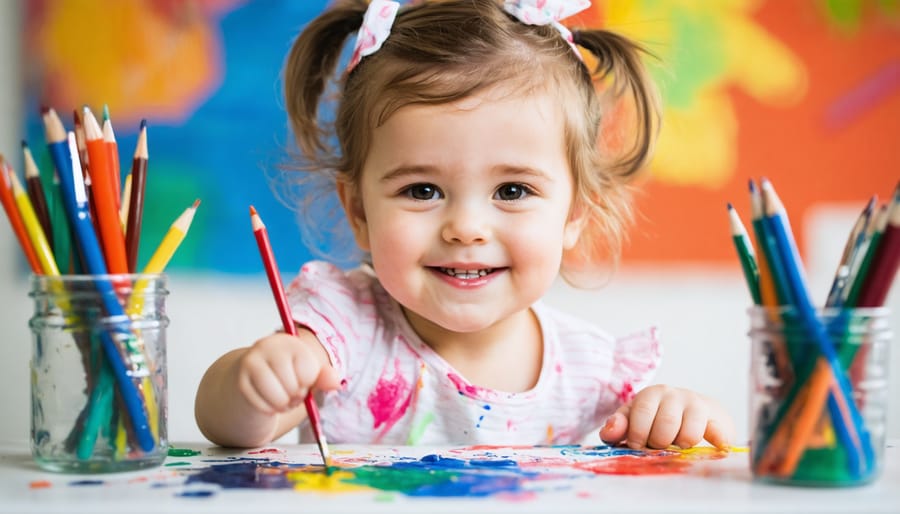
Calm and Peaceful Activities
When children feel overwhelmed or agitated, calm and peaceful art activities can help them center themselves and find emotional balance. Mandala coloring is particularly soothing, as the repetitive patterns help little ones focus and relax. Create simple circular templates with basic shapes for your preschoolers to color, or let them design their own peaceful patterns.
Nature art offers another tranquil creative outlet. Take your children on a mindful walk to collect leaves, flowers, and twigs. Then guide them in arranging these materials into peaceful scenes or patterns on paper. This activity connects them with nature while promoting a sense of calm through gentle, purposeful movements.
Finger painting with cool colors like blue and green can be incredibly calming when done slowly and mindfully. Play soft background music and encourage children to move their fingers in gentle swirls and waves. You might even dim the lights slightly to create a more peaceful atmosphere.
Cloud watching art is another wonderful calming activity. Have children lie on their backs outside, watch the clouds, and then draw the shapes they see using soft pastels or crayons.
Processing Difficult Feelings
When little ones feel big emotions like anger, sadness, or worry, art can provide a safe and healthy outlet for creative emotional expression. Try setting up a “feelings station” with materials like play dough for squeezing, large paper for scribbling, or finger paints for messy expression. When children are upset, gently guide them to this space where they can work through their emotions.
Tear-and-paste collages can be especially therapeutic for anger – the act of ripping paper is physically satisfying while remaining safe. For worried children, creating worry dolls from pipe cleaners and yarn gives them a tangible friend to share their concerns with. Sad feelings can be processed through color exploration, letting children pick colors that match their mood and create abstract paintings.
Remember to avoid judging their artistic choices or asking too many questions. Simply acknowledge their feelings and let them know it’s okay to express themselves through art. This helps build emotional awareness while giving them healthy coping tools they can use throughout childhood.
Group Projects for Social-Emotional Learning
Group art projects create wonderful opportunities for children to develop emotional awareness while learning to work together. A “Friendship Mural” is an excellent starting point – lay out a large paper where multiple children can paint simultaneously, encouraging them to share space and materials while expressing themselves.
Create a “Feelings Garden” by having children work in pairs to make paper flowers. Each flower can represent different emotions, with children discussing their color choices and helping each other glue petals. This activity naturally prompts conversations about feelings while building cooperation skills.
Another engaging project is the “Emotion Orchestra,” where small groups create instruments from recycled materials to represent different emotions. Some children might make angry-sounding shakers while others create gentle rain sticks for calm feelings. When played together, children learn how emotions can blend and change, just like music.
The “Group Mood Collage” lets children collectively sort through magazines, choosing and sharing images that represent various feelings. Working together to organize and glue these images teaches emotional vocabulary while practicing turn-taking and respectful communication.
Remember to celebrate each group’s unique creation and encourage positive feedback between children.
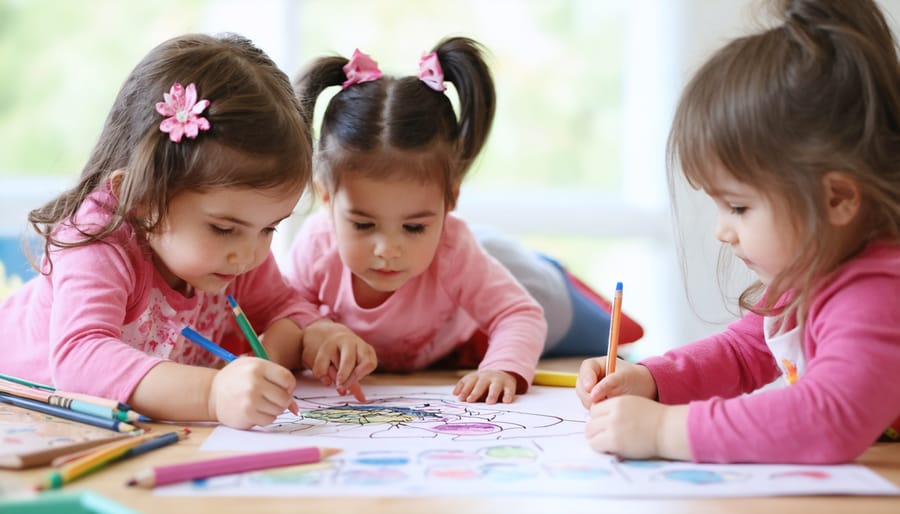
Setting Up an Emotion-Friendly Art Space
Essential Materials and Setup
Before starting any emotional art activities, gather these child-safe materials:
Basic Supplies:
– Construction paper in various colors
– Safety scissors (blunt-tipped)
– Washable markers and crayons
– Non-toxic glue sticks
– Child-safe paint and brushes
– Large drawing paper
– Modeling clay or play dough
Optional Materials:
– Colorful tissue paper
– Stickers with emotional expressions
– Yarn or string
– Paper plates
– Cotton balls
– Craft pom-poms
Setting Up Your Space:
– Choose a well-lit area with easy-to-clean surfaces
– Cover tables with washable tablecloths
– Keep supplies within children’s reach
– Set up a drying area for artwork
– Ensure there’s enough space for movement
– Have clean-up materials ready
– Create a display area for finished pieces
Remember to check all materials for age-appropriateness and always supervise children during crafting activities. Store supplies in clear, labeled containers for easy access and organization.
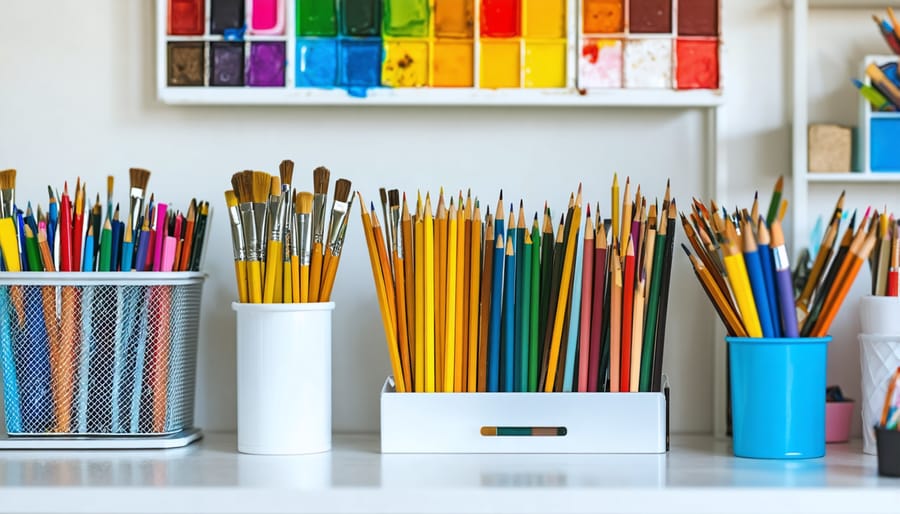
Supporting Your Child’s Creative Process
When supporting your child’s creative expression, remember that the process matters more than the end result. Instead of directing their artwork, encourage exploration by asking open-ended questions like “What colors make you feel happy?” or “Can you show me how you’re feeling through your drawing?” These emotional art activities become more meaningful when children feel safe to express themselves freely.
Avoid making judgments about their work or suggesting corrections. Comments like “That’s beautiful!” or “Maybe make the sky blue instead” can unintentionally shape their creative choices. Instead, try descriptive responses: “I see you used lots of swirling lines” or “Tell me about your picture.”
Create a supportive environment by ensuring materials are easily accessible and messes are okay. Remember to document their creative journey through photos or by writing down their stories about their artwork. This validates their emotional expression while creating lasting memories of their developmental progress.
When to Seek Additional Support
While arts and crafts activities are wonderful tools for emotional expression, sometimes children may need additional support beyond creative activities. Pay attention if your child consistently creates artwork with disturbing themes, shows extreme emotional responses during art sessions, or seems unable to engage with the activities at all.
Watch for signs such as persistent sadness, withdrawal from activities they usually enjoy, aggressive behavior, or difficulty managing emotions even after trying various coping strategies. If your child’s artwork regularly features dark themes, violence, or concerning imagery, this might indicate underlying emotional challenges that need professional attention.
Other red flags include significant changes in sleeping or eating patterns, regression in developmental milestones, or expressing thoughts of hopelessness – even through their artwork. Trust your parental instinct; you know your child best.
Consider seeking guidance from a child psychologist or counselor if these behaviors persist for more than a few weeks or significantly impact your child’s daily life. Many mental health professionals specialialize in art therapy for young children, combining traditional therapeutic approaches with creative expression.
Remember, seeking help early can make a significant difference in your child’s emotional development. Your child’s pediatrician can provide referrals to appropriate mental health professionals who specialize in working with preschool-aged children.
Engaging in artistic activities that explore emotions provides preschoolers with invaluable tools for self-expression and emotional growth. Through these creative projects, children develop a deeper understanding of their feelings while building essential communication and social-emotional skills. The simple act of creating art can become a powerful outlet for young minds to process complex emotions in a safe, nurturing environment.
Remember, you don’t need to be an art expert or child psychologist to get started. The most important ingredients are your presence, patience, and willingness to explore emotions together through creativity. Start with one simple activity that resonates with your child, and watch how their emotional awareness grows through artistic expression.
By making emotional literacy fun and engaging through arts and crafts, you’re helping your little one develop healthy coping mechanisms that will serve them well throughout their lives. So gather your supplies, create a comfortable space, and embark on this colorful journey of emotional discovery with your child today.
